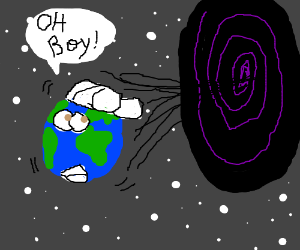


(See " Star Eater" in this month's National Geographic magazine.) So how is such a seed created? One idea, bandied about for several years-notably by Nikodem Poplawski of the University of New Haven-is that the seed of our universe was forged in the ultimate kiln, likely the most extreme environment in all of nature: inside a black hole. If you really want to call something the God particle, this seed seems an ideal fit. And yet it's a particle that can spark the production of every other particle, not to mention every galaxy, solar system, planet, and person. This seed is thought to have been almost unimaginably tiny, possibly trillions of times smaller than any particle humans have been able to observe. Let's call it the seed of a new universe. These physicists theorize that, a moment before the Big Bang, all the mass and energy of the nascent universe was compacted into an incredibly dense-yet finite-speck. Such notions are beyond human understanding.īut a few unconventional scientists disagree. We'll never understand what pre-Big Bang reality was like, or what it was formed of, or why it exploded to create our universe. Time began ticking, they insist, at the instant of the Big Bang, and pondering anything earlier isn't in the realm of science. This happened 13.8 billion years ago.īut what about before that? Many physicists say there is no before that. Before humans existed, before Earth formed, before the sun ignited, before galaxies arose, before light could even shine, there was the Big Bang. Misaligned accretion disks may be common around supermassive black holes, which would spin more slowly and rapidly grow, providing an explanation for how holes that formed in the immediate aftermath of the Big Bang quickly gained so much mass.Let's rewind the clock. He said XMM-Newton was able to follow “an Earth-sized clump of matter for about a day, as it was pulled towards the black hole, accelerating to a third of the velocity of light before being swallowed up by the hole.” While such winds are now found in many active galaxies, PG1211+143 has now yielded another ‘first’, with the detection of matter plunging directly into the hole itself.” “Indeed, some 15 years ago we detected a powerful wind indicating the hole was being over-fed. “The galaxy we were observing with XMM-Newton has a 40 million solar mass black hole which is very bright and evidently well fed,” Pounds said. The UK’s Dirac supercomputer facility indicated such collision would cancel out the rings’ rotation, allowing gas to fall directly into the black hole. The observation agreed with theoretical work that simulated the formation of misaligned accretion disks and subsequent collisions. They observed strongly red-shifted spectra showing trapped gas, with almost no rotation around the hole, being pulled in at 30 percent the speed of light. As it turns out, misaligned rotation can result in multiple rings of debris, providing a mechanism for gas and even entire stars to be pulled into a super-massive black hole from any direction.Ī team led by Ken Pounds of the University of Leicester used the European Space Agency’s XMM-Newton X-ray telescope to observe the surroundings of a 40-million-solar-mass black hole at the heart of a Seyfert galaxy known as PG1211+143 in the constellation Coma Berenices. By definition, the black holes cannot be seen, but they can be detected by the radiation emitted as gas and dust are pulled in and heated to enormous temperatures before crossing the point of no return – the event horizon – and vanishing from the knowable universe.īut even supermassive black holes are so compact gas tends to rotate around them instead of falling straight in, forming a spinning accretion disk in which material spirals inward as it is accelerated by the hole’s enormous gravity.Īstronomers assumed the disk would be aligned with the black hole’s rotation axis, but it was not required. University of LeicesterĪ team of UK astronomers has detected gas being sucked into a supermassive black hole at the core of a galaxy one billion light years from Earth that is racing inward at an extraordinary 30 percent the speed of light, or roughly 100,000 kilometres (62,000 miles) per second.īlack holes with millions to billions of times the mass of the Sun are believed to lurk in the cores of most, if not all, major galaxies.
WILL EVERYTHING BE SUCKED INTO A BLACK HOLE MOVIE
The movie below shows how such “chaotic accretion” might evolve over time. A computer simulation of misaligned accretion disks and rings around a supermassive black hole can collide and tear, allowing gas to fall directly into the central hole at enormous velocities (red arrows).


 0 kommentar(er)
0 kommentar(er)
